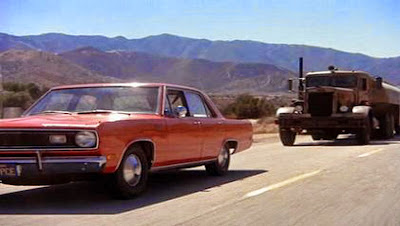'Duel'- Steven Spielberg's first feature film.

-Use of the sound of machines.
-Lack of music until towards the end.
Editing:
-Editing
-Continuity editing (The Hollywood style)
-Montage theory
-Continuity- Story
-Continuity- Drama
-POV
Film editing: 'Invisible Art'; because when done well it is so immersive the viewer doesn't notice the edits.
-Creating drama, emotion, rhythm and action through the combination of shots.
-'The Great Train Robbery'.
-Up to the early 2000s, all films were edited using a machine called a Steenbeck, splicing film together with sellotape.
Linear Video editing- Cannot move shots around.
Video and the MTV cut- having a bank of machines with your source materials, allowing faster access to shots and allowed mixes and dissolves.
Continuity editing:
-The Hollywood Style.
-Take discontinuous shots to create a continuous whole.
-Not necessarily a continuous story or scene, as editing can be used to create a scene that disorients a viewer
Alternatives to Continuity
-French New wave
-Little continuity
Continuity Editing- Story:
-Cutting out material you have shot is the hardest thing to do- especially when you have spent a long time shooting it.
Less = more applies all the way through the editing process.
Drama:
-Pacing, rhythm and emotion.
-pace is effected by the speed of cutting.
-Does not mean 'fast cutting'.
-Getting pacing right is key to creating a great film.
-Too quick- Audience left behind.
-Too slow- Audience might losses interest.
Pacing, Rhythm, Emotion:
-Two people talking.
-Showing either the speaker or listening will create different effects/ responses.
Pacing:
-Start wide and slow, get closer and tighter (usually).
-Always cut for a reason, never just cut. It must ADD to the scene.
Emotion:
-Hold shots longer
-Tension can also require held shots.
Atonement:
-Creating emotion through use of editing.

Match-on-Action:
-Useful tool in editing; match one action with a similar action in a separate shot.
Cross-cutting:
-Can create great suspenseful action scenes.
-Cut between two or more scenes that are occurring at the same time in the story.
Montage:
-Collection shots often set to music, presents a similar series events over a length of time.
Fade/Dissolve
-Fade or dissolve into the next scene, shows time passing.
Editing Stages:
-Log: log and arrange rushes
-Assembly Cut: all scenes put into right order.
-Rough Cut: Cut and remove.
-Fine Cut: Cutting further into scenes.
-Final Cut: Its all done, though you keep tweaking.
No comments:
Post a Comment